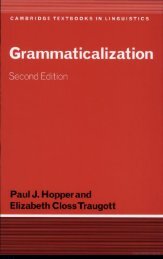What and where? Péter Szigetvári - SEAS
What and where? Péter Szigetvári - SEAS
What and where? Péter Szigetvári - SEAS
You also want an ePaper? Increase the reach of your titles
YUMPU automatically turns print PDFs into web optimized ePapers that Google loves.
<strong>What</strong> <strong>and</strong> <strong>where</strong>? 109<br />
might as well be classified as assimilation, especially, if we consider that [s] turns<br />
into any stop following it: Skt [apaskara] > P [avakka:ra] ‘faeces’, Skt [brhaspati]<br />
> P [bihappai] ‘Jupiter’ (Masica 1991 : 177).<br />
More importantly, if we examine the st<strong>and</strong>ard autosegmental representation<br />
of the change, given in (12), we see that what at first sight looked like fortition<br />
is, in fact, partly lenition, i.e., delinking of melodic material, partly assimilation,<br />
i.e., spreading of melodic material.<br />
(12) The [st] > [tt] change<br />
C1 C2 C1 C2<br />
> ✂<br />
s t s t<br />
The strength of the segment represented by C1 after the changes have taken<br />
place is dependent on whether we include or ignore the association of multiply-linked<br />
melodic material in the calculation of strength. To be less cryptic:<br />
the melodic primes defining [t], associated with C2, make the segment represented<br />
by C2 strong. It seem reasonable, however, not to calculate the same set<br />
of melodic primes again when determining the strength of C1. One reason for<br />
doing so is the fact that geminates are a very unmarked consonant cluster type, 23<br />
a fact that complies with the Complexity Condition (Harris 1990) only if the<br />
complexity of – i.e., number of primes in – the first member is 0. Viewed from<br />
the perspective of segment C1 the process that took place is radical lenition: the<br />
position has lost all its melodic primes. The fact that this – now empty – position<br />
is included in the domain of interpretation of a following segment does not add to<br />
its own melodic complexity. Entertaining a similar idea, Suh (1995) argues that<br />
the first part of a geminate is not even linked to (much of) the melodic primes<br />
defining its identity. 24 Thus a geminate might be represented as in (13), <strong>where</strong> X<br />
denotes the relevant set of melodic primes.<br />
23 One might ask, if geminates are unmarked why are they banned in systems which otherwise<br />
allow consonant clusters. Geminates are probably the least marked cluster type, <strong>and</strong><br />
as such, they might be disallowed in languages, similarly to the fact that the glottal stop,<br />
although the least marked, prototypical consonant, is not part of many consonant inventories.<br />
Probably the ban on empty Onsets in some languages is the manifestation of the<br />
same principle: not only marked, but also extremely unmarked objects are dispreferred in<br />
language (<strong>Szigetvári</strong> 2006).<br />
24 Note that such a representation means a departure from the st<strong>and</strong>ard autosegmental model,<br />
<strong>where</strong> the interpretation of a skeletal slot is a function of the melodic primes associated<br />
with it – as a reviewer points out.
















